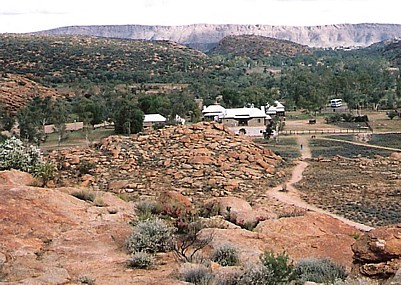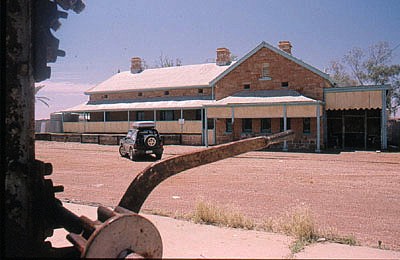 |
 |
Photo taken in 1991 | Photo taken in 1991 |
INTRODUCTION
THE VITAL LINES OF COMMUNICATION
 |
 |
Photo taken in 1991 | Photo taken in 1991 |
 |
|
|
|
|
BROADCASTING
As stated in the first paragraph, the Transmission Section was also responsible for the technical side of national broadcasting in SA and NT which included operation and maintenance of the studios and the transmitters and installation of new facilities. I have included two photos of transmitters as they existed at the time. Technical staff from the Transmission Laboratory group carried out broadcasting installation projects and sometimes used to fill in as maintenance staff. |
 |
around 1946 | commissioned at 5CK Crystal Brook |
WORK FOR OTHER GOVERNMENT ORGANISATIONS
 |
|
Oodnadatta in which the Train Control Console was installed |
|
|
Prior to around 1947, the Department of Civil Aviation (DCA) didn't have the technical staff to build up items of their own radio equipment or carry out radio installation. During my period in the PMG, this work was being done for DCA in SA and NT by our Transmission Section. Towards the end of my stay, I mainly concentrated on work for DCA and other radio work including Broadcasting. A separate sub-section was eventually formed for radio after I left the PMG for employment directly within DCA.
During the war period, another off-shute of the Transmission Section tele-communications work was the installation of Air Raid sirens throughout Adelaide and other parts of the State. I am glad I never became involved in this. Our Laboratory supervisor lost a finger in one of these sirens. THE LINE PARTY I shouldn't forget to mention that a lot of antenna work and mast erection was required for broadcasting installations and for the RAAF and DCA contracts. To do this, we had a radio line party who became specialists in the erection of towers and antenna arrays. I became a close friend with one lineman of around my own age, Aub Johns. He worked on the outside antenna installations and I worked inside on the equipment. Aub eventually climbed the ranks to become Line Supervisor of the radio line party .THE STAFF
(Many were Radio Amateurs) The attached photograph was taken of Transmission Laboratory staff and some of the Clerical staff around 1945. All of the staff members are identified and include the following who have held amateur radio licences: John (Jim) Mollison (VK5MF), Al Smythe (the previous VK5MF), Jim Foster (VK5TX/VK5LU), Bill Walker (VK5WW), Roy Buckerfield (VK5DA), Roy Langford (VK5LM), Lloyd Butler (VK5BR), Les Fieldler (VK5SL) and Ted Reilly (VK5AI). All are now silent keys except myself – I guess I am a survivor.I can also think of a few other members of the Transmission Section staff, who had radio amateur licences and who are not in the photograph: Cliff Moule (VK5CX), Jack Strafford (VK5JS), John Haseldine (VK5JC), Ted Cawthron (VK5JE), John Lamprey (VK5JL), Ray Nottage (VK5MI), Ted McGraph (VK5MO), Murray Higgins (VK5QM) and George Luxon (VK5RX). I think the majority of those have also joined the silent keys. It is interesting to observe from the photograph that despite having virtually no contact with the general consumer public, we all wore ties and in some cases, coats. Who wears a tie these days? I think when WW2 got under way and techniques for long distance communications were rapidly expanding, Frank O'Grady must have put a lot of effort into recruiting staff to carry out the work I have described. Whilst many senior members came from within the PMG system, many of us younger recruits came from outside the Department. I know that some had previously worked in several of the small companies that manufactured consumer radios in Adelaide such as Bland Radio and National Radio. Others, like myself, had worked in commercial broadcast stations. TODAY I have discussed functions of the PMG Transmission Section when I worked there around 1942 /1947. But what changes have occurred over the years? The telecommunication half of the PMG's Department was separated from the Postal half and became Telecom Australia. The Government of the day listed Telecom (exclusively the property of the people of Australia) on the Stock Exchange to become Telstra and gradually sold it back to those who wished to purchase its shares.Telecommunications, once solely owned and operated by the public owned PMG Dept is now in the hands of several competing companies. Telstra still owns the original wired line system. The engineering operation of the National broadcasting studios was taken over by The Australian Broadcasting Commission (ABC) who has been (as long as I can remember) responsible for the programme presentation. Telstra retained control of the broadcast transmitters ( and the later required TV transmitters) after Telstra was established. However the last time I visited the the National broadcast transmitters at Pimpala and the National TV transmitters at Mt. Lofty, maintenance and operation was in the hands of contractors. DCA commenced establishment of its own radio technical staff around 1947 and gradually took over work previously carried out by the PMG Transmission Section. (In fact I moved to DCA for a period and supervised some of their installations and their Regional Radio Workshops at Parafield). A new standard gauge train line to Alice Springs via Tarcoola , Marla and Kulgera was built, which avoided much of the flood damage and disruption to service experienced with the old narrow gauge line. More recently the line was extended to Darwin. The Ghan is now operated by Great Southern Railway. I understand that maintenance of the train line and provision of locomotives is also carried out by other contractors. |